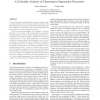64 search results - page 1 / 13 » Application of instruction analysis scheduling techniques to... |
TVLSI
2002
13 years 4 months ago
2002
This paper presents the development of instruction analysis/scheduling CAD techniques to measure the distribution of functional unit usage and the micro operation level parallelis...
MICRO
1992
IEEE
13 years 8 months ago
1992
IEEE
An important design decision in the implementation of a superscalar processor is the amount of hardware to allocate to the instruction scheduling mechanism. Dynamic scheduling pro...
ISSS
1998
IEEE
13 years 9 months ago
1998
IEEE
Designing a cost effective superscalar architecture for x86 compatible microprocessors is a challenging task in terms of both technical difficulty and commercial value. One of the...
ASPLOS
1992
ACM
13 years 8 months ago
1992
ACM
The foremost goal of superscalar processor design is to increase performance through the exploitation of instruction-level parallelism (ILP). Previous studies have shown that spec...
MICRO
2005
IEEE
13 years 10 months ago
2005
IEEE
Clustered machines partition hardware resources to circumvent the cycle time penalties incurred by large, monolithic structures. This partitioning introduces a long inter-cluster ...

